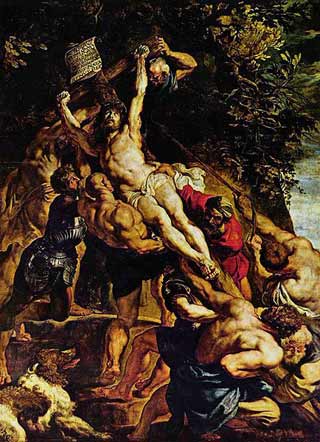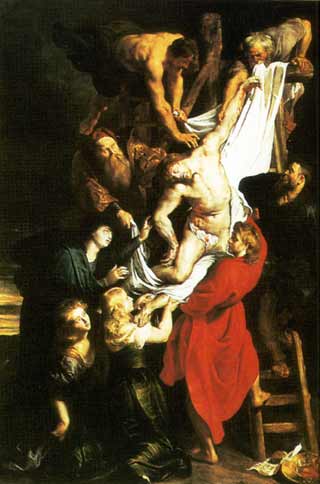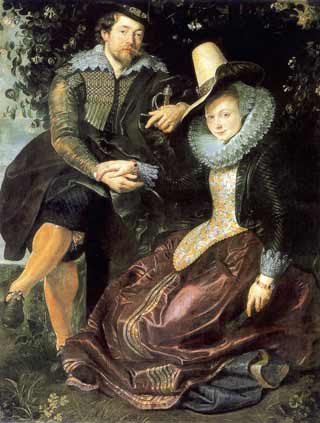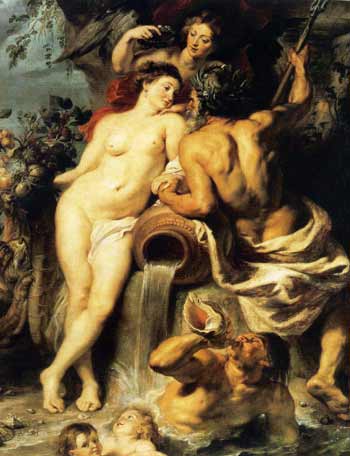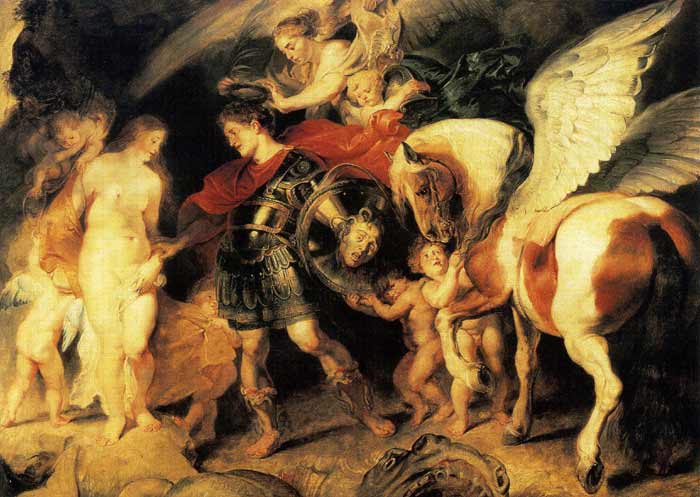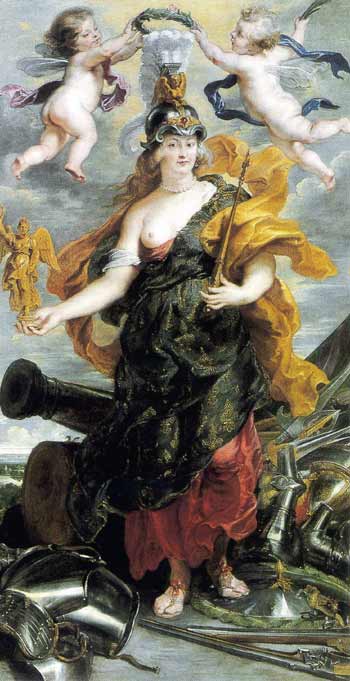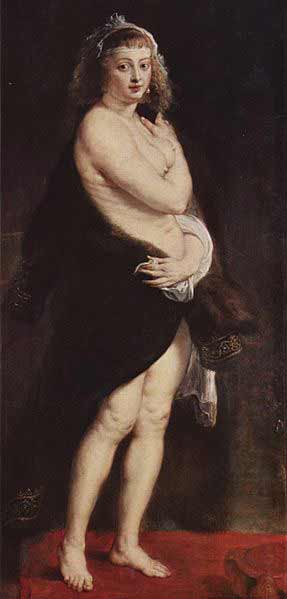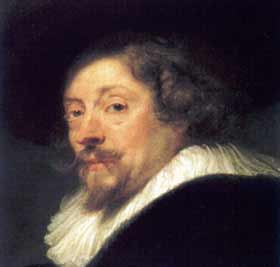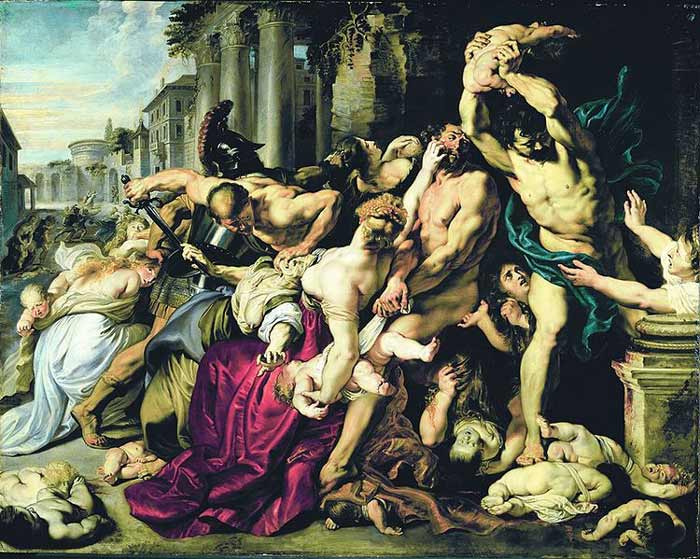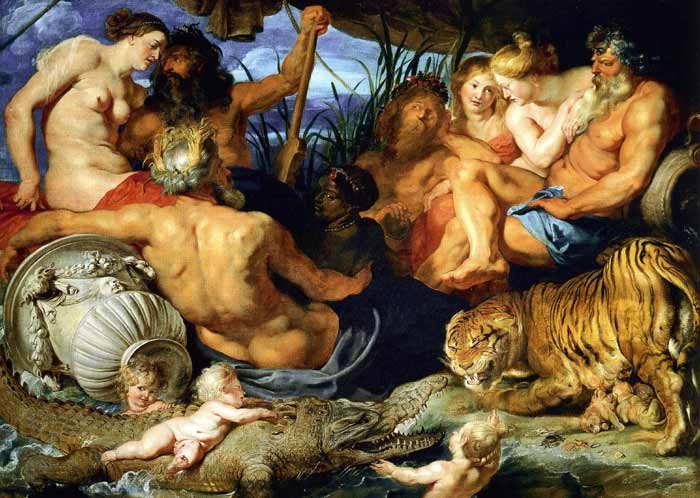
The women represent the four known continents. Africa is the black woman in the middle, Asia and America are the two blondes, and Europe is the sassy brunette. Antarctica hadn’t been discovered yet, and the Americas were viewed as a single continent. Most Europeans considered stories of “Terra Australis”, the mysterious land to the far South, to be rumors until Captain Cook more extensively explored Australia almost two centuries after this painting was completed. Interesting how Europeans don’t believe anything exists until some white guy says it does.
Africa is the only non-European character Rubens attempted to portray with any degree of ethnic realism. Perhaps the slave trade gave him contact with Africans he simply didn’t have with Asians and Native Americans; though Rubens drew a highly realistic sketch of a Korean man not long after this, suggesting some degree of contact with the far East. Or maybe Rubens was just a product of his Eurocentric, racist times. To be fair, Africa is portrayed as an attractive, goddess-like figure in the center of the composition rather than the groveling servant one typically sees in paintings of the era. However, her position in the shadows of the others in the arms of a white man speaks volumes of the subservient image Europeans had of Africans.
The ripped, bearded guys putting the moves on the girls are in fact river gods, representing the great rivers of the world. The Nile embraces Africa, the Danube is next to Europe, and the Ganges and Rio de la Plata are snuggling up to Asia and America.
Rubens didn’t portray female anatomy any more accurately than he did ethnicity. Rubens is legendary for his voluptuous female figures, though the ladies here seem more muscular...almost androgynous. Male artists of the time had limited access to live female models, relying primarily on brief glimpses of their wives and mistresses before sexy times, when they were thinking with their other paintbrushes, if ya’ know what I mean. Consequently, Rubens sometimes improvised by painting boobies and wide hips onto male models, hence Europe’s Gerard Butler biceps and tiny, overly high breasts.
If the crocodile’s bizarre, crooked snout is any indication, Rubens didn’t fare any better as a zoologist than he did as an anthropologist or female anatomist. The snarling tigress protects her suckling cubs from the encroaching river beast. She’s a much more protective mother than whatever idiot thought it would be a good idea to let her babies ride a crocodile.
Les Quatre Continents
Sauter à la navigationSauter à la recherche
Les Quatre Continents
Peter Paul Rubens - The Four Continents.jpg
Artiste
Pierre Paul Rubens
Date
Vers 1615
Type
Allégorie
Matériau
huile sur toile
Dimensions (H × L)
209 × 284 cm
Collection
Musée d'Histoire de l'art de Vienne
N° d’inventaire
GG_526
Localisation
Musée d'Histoire de l'art de Vienne
modifier - modifier le code - modifier WikidataDocumentation du modèle
Les Quatre Continents, connue également comme Les Quatre Fleuves du Paradis, est une peinture à l'huile de l'artiste flamand Pierre Paul Rubens, datant des années 1610. Il peint les personnifications féminines de quatre continents (Europe, Asie, Afrique et Amérique) assises avec les personnifications de leurs grands fleuves, le Danube, le Gange, le Nil et le Río de la Plata1. Il est exposé au Kunsthistorisches Museum de Vienne.
Sommaire
1 Description
2 Interprétations
3 Notes et références
4 Liens externes
Description
L'Europe se trouve à gauche, l'Afrique au milieu, l'Asie à droite et l'Amérique derrière, à gauche. La tigresse, protectrice de la progéniture contre le crocodile, est utilisée comme symbole de l'Asie. La personnification du Danube tient un gouvernail. La partie inférieure de la peinture montre plusieurs putti. Peint au cours d'une période de trêve entre la République Néerlandaise et l'Espagne, les allégories des fleuves et leurs compagnes féminines, dans le luxe et l'abondance, reflètent les conditions que Rubens espérait pouvoir retourner à Anvers, après les opérations militaires2.
Interprétations
L'historien de l'art Elizabeth McGrath a proposé une autre interprétation des figures féminines sur la peinture, pensant qu'elles étaient en fait desnymphes représentant les sources des fleuves3. McGrath a également suggéré d'autres noms de fleuves, le Tigre à la place du Danube et l'Euphrate, au lieu du Río de la Plata, arguant que ces noms apparaissent également dans l'exégèse chrétienne.
Peter Paul Rubens.
The Baroque artist and Diplomat.
The great 17th-century Baroque artist Peter Paul Rubens was born on the 28th June 1577 at Siegen, Westphalia in Germany. He was greatly influenced by the Italian Renaissance artists Michelangelo, Raphael and Leonardo da Vinci in addition to the Venetian masters Titian, Veronese and Tintoretto. His father Jan was a barrister and Peter Paul was the sixth child of Jan and his wife Maria Pypelinckx.
The family had fled Antwerp because of the persecution of Protestants by the Spanish Duke of Alba (Jan was a Calvinist) at this time the Netherlands were controlled by Spanish rule. On the death of her husband in 1589 Maria returned to Antwerp with her six children who she raised as Catholics.
Rubens artistic education started as an apprentice to Tobias Verhaecht, he also studied under the leading Antwerp artists Adam van Noort and Otto van Veen. He completed his training in 1598 by becoming a Master of the Antwerp Guild of St Luke.
Throughout his career, Rubens was a fervent traveller. Arriving in Italy in 1600 he settled in Mantua becoming court painter to the Duke of Mantua, Vincenzo Gonzaga where, (except for a diplomatic journey to Spain in 1603), he remained for eight years. Between 1606 to 1608 he lived and worked in Rome where he was influenced by his contemporaries Caravaggio and Annibale Carracci.
Unfortunately, the artist's mother had contracted an illness that hastened Ruben's return to Antwerp. He left Rome in 1608 but arrived too late, his mother had died before he could make it home.
On 23rd September 1609, Rubens was appointed Court Painter to the Archduke Albert VII of Austria and his wife, The Infanta Isabella Clara Eugenia, the Habsburg Regents in Flanders.
Fame and Marriage.
Although the Habsburg Court was in Brussels Rubens obtained special permission to base his studio in Antwerp. On October 3rd he married the daughter of an Antwerp barrister, Isabella Brant and painted a self-portrait with his new wife.
Ruben's workshop was very successful with many apprentices learning their trade from the master painter. His Altarpieces for Antwerp Cathedral, The Elevation of the Cross and The Descent from the Cross, established the artist as the leading painter in Flanders.
Rubens Mythology.
In addition to his many religious works, Rubens completed many paintings of subjects from mythology. In these works, the artist clearly enjoys the freedom as expressed by his rather fleshy nudes.
The Four Parts of the World. 1612-1614. Oil on canvas. Kunsthistorisches Museum, Vienna, Austria. (s)
This superbly executed painting represents the four continents of Asia, America, Europe and Africa twined with their respective rivers. In the foreground, the river Nile has his arm around the black beauty of Africa. Behind them on the left of the picture are Europe with the river god of the Danube. On the right is Asia with the Ganges and at the back is America with the god of the Rio de la Plata.
Perseus and Andromeda. c.1620, Oil on Canvas. 99.5 x 139cm. The Hermitage, St Petersburg. (s)
This is a real Clash of the Titans moment with Perseus rescuing the naked Andromeda from the Kraken (you can just see the stricken sea-monster at the bottom of the painting). The beast has been turned to stone by the reflection of the Medusa on the shield of Perseus. The winged horse Pegasus completes the picture.
Rubens the Diplomat.
In February 1622 Rubens was commissioned to produce a large series of paintings, The Life of Marie de' Medici. Marie was the second wife of King Henry IV of France. Following her husband's assassination in 1610, she became regent until her son, the future King Louis XIII, came of age. She was a member of the powerful Medici banking family of Florence.
The Medici were great patrons of Renaissance art and Marie herself was famed for her own artistic patronage.
Portrait of Marie de' Medici, 1622-1625. Oil on canvas, 276 x 149cm, Louvre, Paris. (s)
It's difficult to imagine a modern-day Queen posing, bare-breasted, for an official portrait!
His Habsburg employers entrusted the artist as a diplomatic envoy and he received a monthly allowance, decreed by The Infanta Isabella, Vice -Regent of Flanders.
Rubens travelled between the Courts of Spain and England and his missions were rewarded with two knighthoods, the first in 1624 by Philip IV of Spain and then by Charles I of England in 1630. His diplomatic work did not seem to have an adverse effect on his art, in addition to his work for private patrons, the prolific painter completed many commissions for Philip of Spain.
Sadly it was during this period that his wife, Isabella Brandt, died on 20th June 1626.
On 5th June 1629, Rubens arrived in London to conduct peace negotiations between England and Spain. He painted his Peace and War and presented this allegorical work to Charles I. Charles also commissioned him to work on a series of nine ceiling paintings for the Banqueting House in London. Further recognition of the artist's skills came when he was made an honorary Master of Arts by Cambridge University.
The artist returned to Antwerp from London in April 1630 and on 6th December married Helene Fourment the daughter of a rich tapestry dealer Daniel Fourment. Helene was sixteen years old when she married the fifty-three-year-old artist, she inspired many of the artist's later works acting as a model for many of them. Ruben's portrait of her in a fur wrap is a particularly famous example of the artist's intimate obsession with his new wife.
In 1634 the city council of Antwerp commissioned the artist for a series of sketches of triumphal arches. these were designed for the ceremonial reception of the new Governor, the Cardinal-Infante Ferdinand. Rubens was made Court Painter to Ferdinand and received a commission for 112 paintings based on Ovid's Metamorphoses.
In 1635 the artist purchased the Chateau de Steen near Elewijt, a village in the municipality of Zemst, Flemish Brabant, Belgium. He was to spend many summer months at the Chateau where he painted his final landscapes in and around the locality.
The Massacre of the Innocents. 1611-1612, Art Gallery of Ontario, Toronto. (w)
This work was only attributed to Rubens in 2001. It was thought to be by one of his assistants until an expert in Flemish art (George Gordon) recognised the painting as the work of the master himself. It was sold at auction at Sotheby's on July 10th 2002 for the sum of £49.5 million. It is a very dramatic and quite graphic account of the Biblical story in which King Herod orders the slaughter of every new-born male child in the village of Bethlehem. His motive was to avoid the loss of his kingdom to the King of the Jews whose birth had been announced in a prophecy.
PETER PAUL RUBENS: THE FOUR CONTINENTS (1612-1615)
(Kunsthistorisches Museum, Vienna, Austria)
A painting by the Flemish artist Peter Paul Rubens (1577-1640). This painting has several interpretations of what the 4 old men and the 4 young women represent. Traditionally they represent the four parts of the world with their main streams: Europa with the Danube, Asia with the Ganges, America with the Rio de la Plata and Africa with the Nile. A new interpretation sees in the in the men and women the 4 great rivers of the classical antiquity: the Nile, Euphrates, Tigris and the Ganges together with their sources. Another interpretation sees in them the 4 rivers of paradise: Pishon, Gihon, the Tigris, and the Euphrates (Genesis 2:10-14). Painting from 1612-1615.
